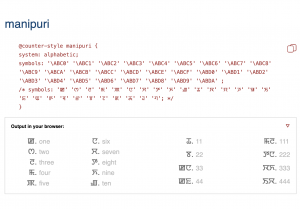Category: alreq
Posts
New translation into Persian
چرا از ویژگی زبان استفاده کنیم؟ (Why use the lang attribute?)
Thanks to Goudarz Jafari for providing this translation!
New First Public Working Drafts: Latin, Arabic, Hebrew, Chinese
The Internationalization Activity has just published the following FPWD documents.
- Latin Script Resources
- Latin Gap Analysis
- Arabic Script Resources
- Hebrew Script Resources
- Chinese Script Resources
The documents related to language enablement at the W3C are being refactored to represent scripts, rather than individual languages. These newly published -lreq documents should be a first port of call for information related to a given script. They point to descriptions about how the scripts work, to tests, to discussions, to type samples, and more, all organised by topic.
Comments welcome, via the GH links indicated at the top of each page.
New article: How can I use direction metadata in native APIs?
The article How can I use direction metadata in native APIs? has now been published.
This article provides links to documentation in many different operating systems, programming environments, and user experience frameworks. These APIs can then be used to consume language and string direction metadata received on the Web or in other APIs or formats.
New First Public Working Drafts: Kashmiri, Urdu, Uighur
The Internationalization Activity has just published the following FPWD documents.
These languages are all written right-to-left (based on the Arabic script) and are used in India, Pakistan, and Western China. Urdu & Kashmiri are normally written in the nastaliq writing style.
Currently, these documents mostly point to external descriptions of how the script works. They also point to relevant GitHub discussions, tests, and gap reports. This provides a convenient way to access information about a particular script/language when doing gap analysis as part of our language enablement program.
Comments welcome, via the GH links indicated at the top of each page.
New First Public Working Drafts
The Internationalization Activity has recently published the following FPWD documents.
Thus far, these documents mostly point to external descriptions of how the script works. They also point to relevant GitHub discussions, tests, and gap reports. This provides a convenient way to access information about a particular script/language when doing gap analysis as part of our language enablement program.
Similar structural changes have been applied to the following documents, although these documents contain much more in-page content.
Comments welcome, via the GH links indicated at the top of each page.
WEB I18N GAP FIXED: Interoperable custom counter styles
All 3 major browser engines now support the ability to create custom counter styles.
This is a significant step forward in enabling fully interoperable list numbering and other counters that reflect local approaches, especially for languages with smaller speaker populations.
See the Gap report.
See also Ready-made Counter Styles to use or adapt almost 200 suggested patterns from around the world.
Updated: Ready-made Counter Styles
The Ready-made Counter Styles document provides ready-made definitions for counter styles and covers the needs of a range of cultures around the world. The code snippets provided in the document can be included in style declarations by simply copying and pasting, or they can be use as a starting point and modified as desired.
This update brings the total number of style templates to 177, covering 44 writing systems.
Substantial changes were also made to the styling and presentation. Each template is now accompanied by a set of examples, as well as an icon that copies the template to your clipboard in a single click. Another icon points to MDN’s roundup of browser support for named styles. Extensions to cover affix variants are now expressed in terms of the extends syntax.
Fixes were applied for tai-lue and warang-citi styles.
Finally, a button is provided to allow you to turn off all counter styling for the examples. That then allows you to see which styles have built-in support in the browser you are using.
Updated article: How to use Unicode controls for bidi text
The W3C Internationalization Activity has updated the article How to use Unicode controls for bidi text.
This article looks at how content authors can apply direction metadata to bidirectional text when markup is not available. It was largely rewritten to incorporate more up to date information and improve the examples.
New article: Working with source code markup and code examples for RTL scripts
The W3C Internationalization Activity has published the article Working with source code markup and code examples for RTL scripts.
Editing markup for pages in Arabic, Hebrew, and many other languages poses challenges unless a specialized editor is available. For similar reasons, it is also difficult to include examples of bidirectional code in explainers. This page looks at some of the problems content developers and implementers of editors are likely to be faced with, and offers some advice, where possible.
For review: Working with source code markup and code examples for RTL scripts
The article Working with source code markup and code examples for RTL scripts is out for wide review. We are looking for comments by Wednesday 26 April.
Editing markup for pages in Arabic, Hebrew, and many other languages poses challenges unless a specialized editor is available. For similar reasons, it is also difficult to include examples of bidirectional code in explainers. This page looks at some of the problems content developers and implementers of editors are likely to be faced with, and offers some advice, where possible.
Please send any comments as github issues by clicking on this link, or on “Leave a comment” at the bottom of the article. (That will add some useful information to your comment.)
W3C® liability, trademark and permissive license rules apply.
Questions or comments? xfq@w3.org


